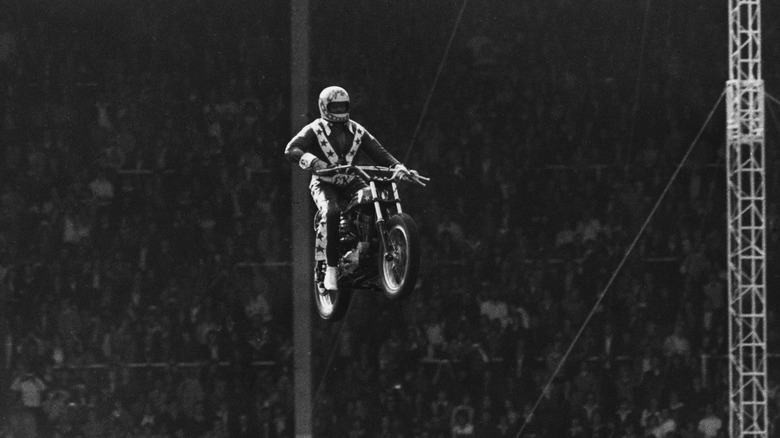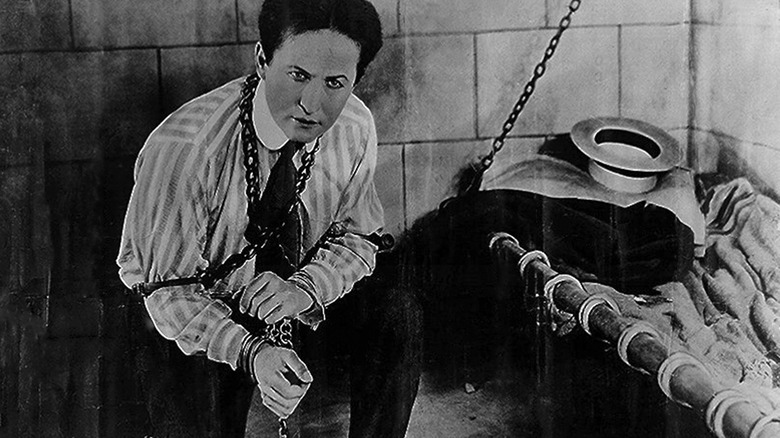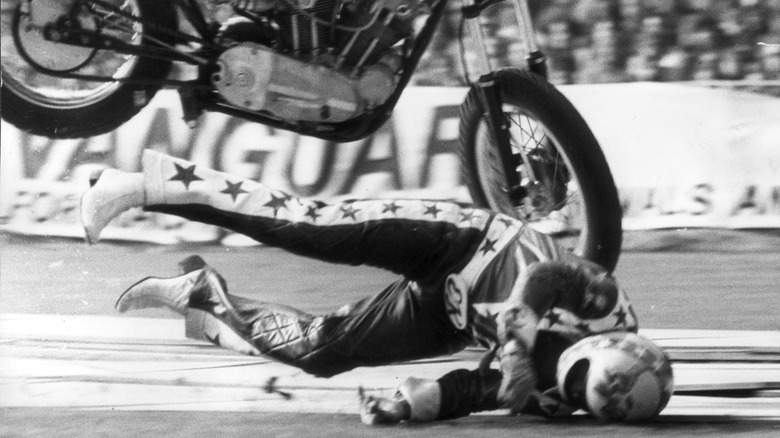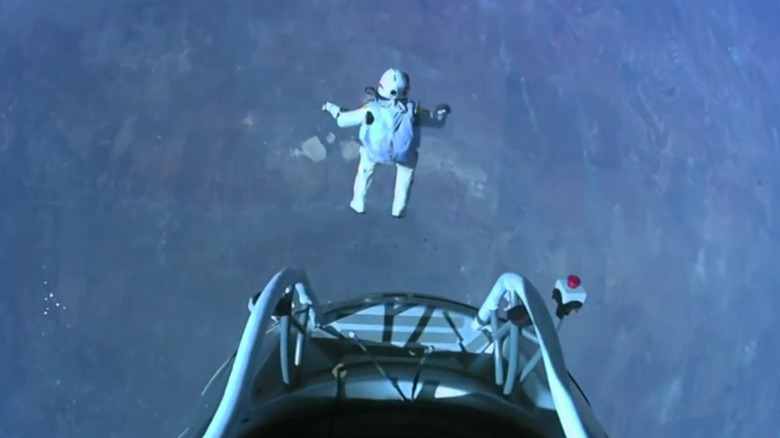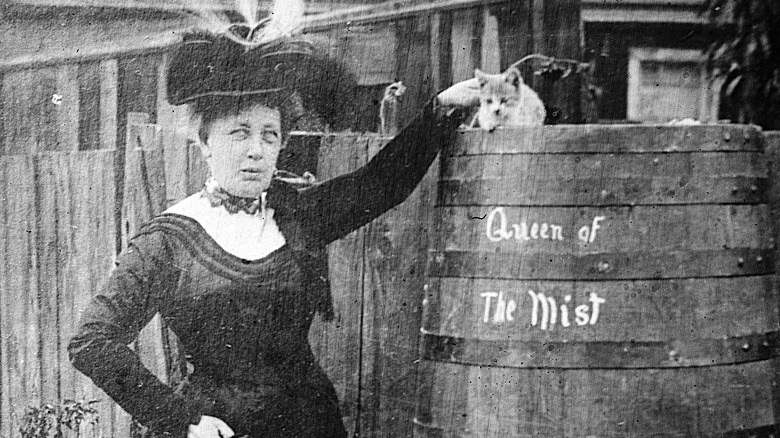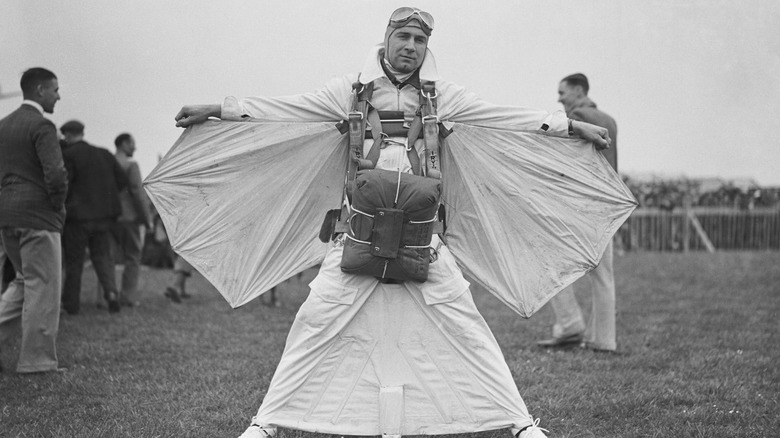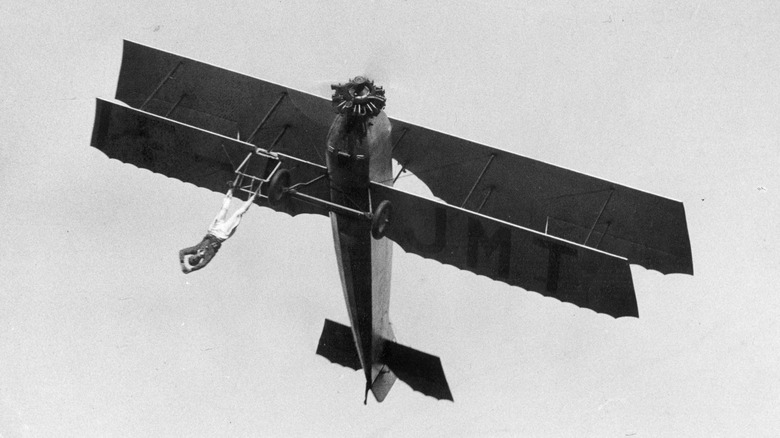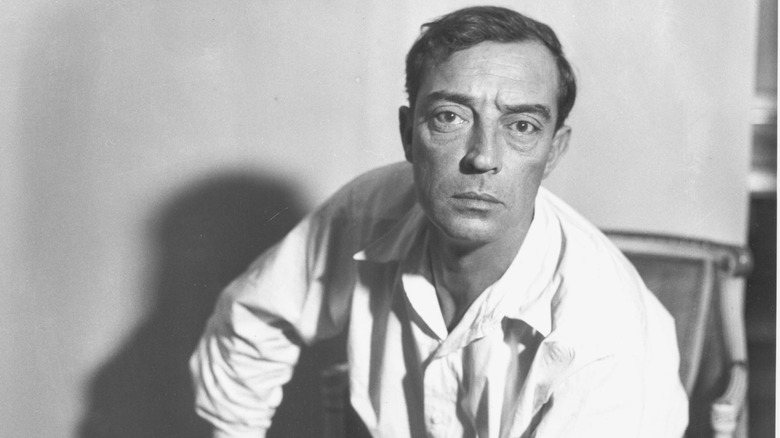Daredevils That Barely Escaped Tragic Accidents
The Merriam-Webster Dictionary gives two definitions of the word "daredevil," and neither of them is particularly positive: either a person who is "recklessly and often ostentatiously daring" or "a recklessly bold person."
It's hardly debatable that daredevils are cut from a different cloth than the rest of us. They willingly put themselves in precarious, dangerous, and often life-threatening situations that most of us would take great pains to avoid. Why? There are several reasons, according to The Economist. One is of course money. While not nearly as lucrative a profession as it was in the last century, a person can make a decent chunk of change by performing wild stunts that thrill and amaze a crowd. Some do it in the pursuit of fame. And some take risks simply for the thrill and the exhilaration.
While most professional daredevils, if such a term can be used (in some cases stuntman or stuntwoman is more appropriate, and in others perhaps extreme athlete more on point), do employ logical safety measures during their feats, such as helmets, test runs, and medical crews on standby, the mere fact that an activity merits those precautions and more means there should be little surprise that accidents can and do happen. And they are indeed often deadly.
Here are some daredevils who survived tragic accidents that could well have been their final acts.
Harry Houdini
The fear of being buried alive is called "taphophobia," according to Vox, and it is a powerful fear indeed. So much so that there have even been myriad patents filed for coffins with built-in signaling devices a person wrongly assumed to be dead can use to call for help from their place of entombment. In short, most people would not voluntarily be buried alive. But Harry Houdini was not most people. The world-famous escape artist, illusionist, stuntman, magician, and a host of other terms was known for his willingness to put himself in extreme situations — or rather to get himself back out of said situations, to be more accurate.
But one time, he almost didn't get back out. During a 1915 stunt, Houdini had himself placed in shackles, secured in a coffin-like box, and then had the box buried beneath six feet of sandy soil, according to History. Escaping and getting the box open took longer than the pioneering daredevil had counted on, and he nearly lost consciousness as he ran out of oxygen. After managing to scramble up through the dirt, Houdini was close to death and needed to be aided by assistants, who rushed to help him, via Mental Floss.
Evel Knievel
In one fell swoop, Evel Knievel broke several bones, endured a concussion so severe he would be hospitalized for a month, and also secured global recognition as a daredevil. Born Robert Craig Knievel in October 1938 (via evelknievel.com), Knievel was 28-years-old at the time of that fateful jump, which took place on New Year's Eve 1967, according to Biker Nation.
The failed jump (and successful PR stunt) took place at the Caesar's Palace casino in Las Vegas, Nevada. Knievel planned to soar across the massive fountain in front of the casino on his Triumph Bonneville t120 motorcycle but later reported that the bike's engine lost power right as he was ascending the ramp off which he'd jump the bike. Without sufficient speed to clear the gap as needed, the daredevil came to earth well short of his planned landing spot and was horribly injured in the crash.
Having had the event captured on film, Knievel sold the footage to ABC, the fact that it was of a crash likely adding to the value of the sale and helping increase the stuntman's fame. And the crash certainly didn't diminish Knievel's taste for danger. Despite his injuries and brush with death, Knievel would go on to complete more jumps, remaining active until the early 1980s, as per his website.
Jonathan Goodwin
Jonathan Goodwin is a worthy successor to Harry Houdini, if anyone alive can be called so. In fact, he was even inspired to pursue the life he has after reading about Houdini at the age of 7, he told The Mirror. So far, this Welch-born daredevil's exploits have included hanging suspended beneath helicopters, free climbing and free diving, knife throwing, and being attacked by sharks and venomous snakes, as per his website, just to scratch the surface.
Goodwin got more than his share of scratches, however, when one of his most audacious stunt attempts went terribly wrong. While preparing for a stunt on the Simon Cowell-helmed show "America's Got Talent: Extreme," which Deadline described as a "showcase [of] the most outrageous and jaw-dropping daredevil acts," Goodwin was injured so grievously it's rather amazing he survived.
For the stunt, the daredevil was hanging dozens of feet up in the air, shackled, with two cars suspended near him. The idea was for him to slip his bonds and climb to safety before the hanging cars collided with one another, but when a rope snapped, he was crushed between the cars. The cars then burst into flame, and Goodwin fell some 40 feet to the ground, landing on his head, reports TMZ, which broke the story. Amazingly, Goodwin lived and even poked fun at his near-death accident from his hospital bed.
Felix Baumgartner
Felix Baumgartner almost entered a "death spin" while falling at Mach 1.25. That's right, this human being broke the sound barrier, and not in a plane but while in free fall, reports The Washington Post. On October 14, 2012, the Austrian daredevil stepped off a platform hung 127,852 feet above the surface of the earth (also known as around 24 vertical miles) and would spend the next four minutes and 22 seconds in free fall, according to the daredevil's website. During his fall back to earth, which was possible only because Baumgartner wore a pressurized suit that kept him safe at the extreme altitude and from the force of air through which he fell, the man hit a speed of 843.6 miles per hour.
Near the end of his free fall, Baumgartner entered an uncontrolled spin that, had he not been able to recover from, would almost surely have led to his death, as per The Guardian. Had he spun too fast for too long, the force of the spin alone could have been lethal, or it could have compromised the ability of his parachutes to properly deploy.
Annie Taylor
The minute Annie Taylor's death-defying feat was done, she knew it was something she'd never want to do again. The exploit in question was going over Niagara Falls in a barrel, and of it Taylor would later say: "If it was with my dying breath, I would caution anyone against attempting the feat. I would sooner walk up to the mouth of a cannon, knowing it was going to blow me to pieces, than make another trip over the Falls," according to WITL. While Taylor received relatively minor injuries in the plunge, primarily a cut on the head, she was knocked around violently during her plunge over the falls, as per History. In fact, as reported by the New York Times, Taylor felt as if she "were being suffocated," packed into her barrel before her stunt.
The circumstances leading up to this risky undertaking were odd enough: Taylor, who turned 63 the day of the plunge on October 24, 1901, had fallen on hard times. A widow whose only child had died when very young, she had tried everything from being a school teacher to running a dance studio to giving music lessons, but she was near destitute nonetheless, reports WBFO. She hoped to use her trip over Niagara Falls to gain some fame and, much more to the point, to make some money. But despite a bit of attention and a few paid public engagements shortly after the event, interest faded fast, and she was soon broke again. Sadly, she died alone in a poorhouse.
Clem Sohn, the 'Bird Man'
So you thought wingsuit-wearing BASE jumpers soaring around through mountain peaks and passes were thoroughly modern thrill seekers? It turns out there was a wingsuit fan nearly a hundred years ago. According to History, Clem Sohn, a Michigan native, would gain a degree of world fame before it all came crashing down. Sohn crafted a one-of-a-kind flying suit made of canvas fabric stretched over a frame of metal rods, and when he spread his arms and legs wide, his suit allowed him to glide through the air, sometimes for many miles.
Sohn would leap out of planes to commence each wingsuit flight, soaring about to the delight of crowds below, his progress tracked by a stream of flour billowing out from a sack he carried to create a visible trail. Sohn nearly died not once but multiple times when he lost control of his wingsuit and/or his parachutes did not deploy properly. During one stunt at London's Gatwick Airport in the early 1930s, as Michael Abrams details in "Birdmen, Batmen, and Skyflyers," Sohn's parachute tangled in his suit, and his reserve only narrowly saved his life — he still crashed into a taxi and only miraculously broke his arm.
His narrow escapes, however, eventually ran out. In the early spring of 1937, Sohn fell to his death after yet another accidental gear failure. Tens of thousands of people were on hand and watching as the 26-year-old American plummeted earthward over Paris, where he and other aerialists and pilots had theretofore been thrilling the crowds.
Joe Bonomo
The first few decades of the 20th century were a heady time in many ways, especially for those who worked in the new fields of filmmaking and aviation. And when the two of those crossed over, things went from heady to outright wild. Stuntmen and stuntwomen of the 1910s and '20s went to ludicrous lengths to perform feats to delight audiences, according to History Net. This included things like wing walking, trapeze acts suspended from planes, staged crashes, and of course the actual barnstorming that gave the daredevils their name — barnstorming being the act of traveling the rural countryside performing aerial stunts, according to the Wall Street Journal.
A luminary among this group (which is to say someone even other barnstormers thought crazy) was Joe Bonomo, a man who had completed all sorts of wild acts and was an avid parachutist in the early days of said hobby. Bonomo once proposed a stunt so dangerous that literally no other stuntmen agreed to do it with him: Two men would leap from a plane with one shared parachute. Not to be dissuaded from the act, Bonomo instead leaped from a plane clutching a dummy. And the dummy ended up saving his life, as when Bonomo landed in the water after the drop, fierce wind gusts wrenched him sideways over the water. He would almost surely have drowned had not the dummy been quite buoyant, serving as an impromptu life raft.
Larry Walters
Larry Walters was about as unlikely a daredevil as Annie Taylor. But unlike her, his wild feat would not take him down a waterfall but up into the air. And also unlike Taylor, Walters wasn't seeking fame or fortune — he was just bored.
A truck driver living in North Hollywood who was 33 at the time of his aerial exploit, Walters later said he had dreamed of doing something extreme since he was a young teenager, according to The New York Times. What he did was connect 45 six-foot diameter helium-filled weather balloons to a lawn chair, add some ballast in the form of water jugs, and lift off into the skies above Los Angeles.
Walters had put a few safety precautions in place. He had a parachute, for example, and a BB gun he would use to shoot a balloon or two when it was time to descend. Walters also had a radio he would use to put out a distress call once he realized he had not accounted for all aspects of the flight properly. Once the lines holding Walters down were severed, he zipped into the sky much faster than anticipated — and he got up much higher than he expected, reaching an altitude of 16,000 feet. Hands nearly too numb to work his gun, he eventually shot several balloons and descended, only to become ensnared in power lines that could have killed him instantly. He eventually reached the ground unharmed, but his landing did knock out power to part of the city of Long Beach.
Buster Keaton
Buster Keaton was the OG stuntman. Or rather, he was the original "I do my own stunts" kind of actor, with people like Jackie Chan proudly drawing inspiration from the Vaudeville and early Hollywood star, via Mental Floss. Keaton performed dozens of hair-raising stunts in his day, including having the façades of buildings crash down around him, jumping on and off moving trains, leaping from building to building, jumping into and out of moving cars, falling out windows, swinging around in waterfalls, and on the list goes.
In performing one particular stunt that didn't seem all that precarious when compared to the wildest acts of his oeuvre, Keaton came within a hair's width of death, though. It was the water tower stunt in the film "Sherlock Jr." In the scene, Keaton first rides atop a train, then clings to the spout of a water tower set beside the tracks, as per Far Out Magazine. When the spout is pulled down by his weight, the ensuing torrent of water knocks Keaton to the ground, which was supposed to be comical. Except that Keaton landed on the rails and fractured his neck.
In agony but a relentless performer if ever there was one, Keaton went on with the production and never sought treatment for the injury — for despite the pain, he had no idea how bad his injury was, or that had he landed ever so slightly differently he would have been paralyzed or killed. The injury was discovered many years later when he was X-rayed for unrelated purposes.
Alain Robert
Alain Robert isn't called the French Spider-Man for his web-slinging abilities, because he can't shoot out webbing. But he doesn't need webs or any other sort of harnesses, because he is such an accomplished and capable free climber that such gear would just slow him down. Much like the Marvel comic superhero, Robert is known to climb buildings with ease, though his ascents usually end not in saving some innocent victim from a villain, but in arrest. The climber has (illegally, in most cases) scrambled to the top of the Empire State Building, the Eiffel Tower, and Taipei 101 (via NBC News), to name a few.
Along with notching dozens of successful climbs, Robert has also nearly died on several occasions, though notably all of them were when he was a much younger man. His worst accident ever occurred in 1982, according to Gym Climber Magazine, when Robert fell nearly 50 feet while rappelling during a rock climbing outing. The fall left him in a five-day coma and with multiple fractures.
The accident happened when he was using ropes. Now in his 60s, has not had a fall in years, and he always free climbs. So is he a daredevil on the edge? Sure, but he is also very good at what he does. And he has no plans to stop, according to Forbes, having said, "I will continue until the end of my life, whenever that may be."
